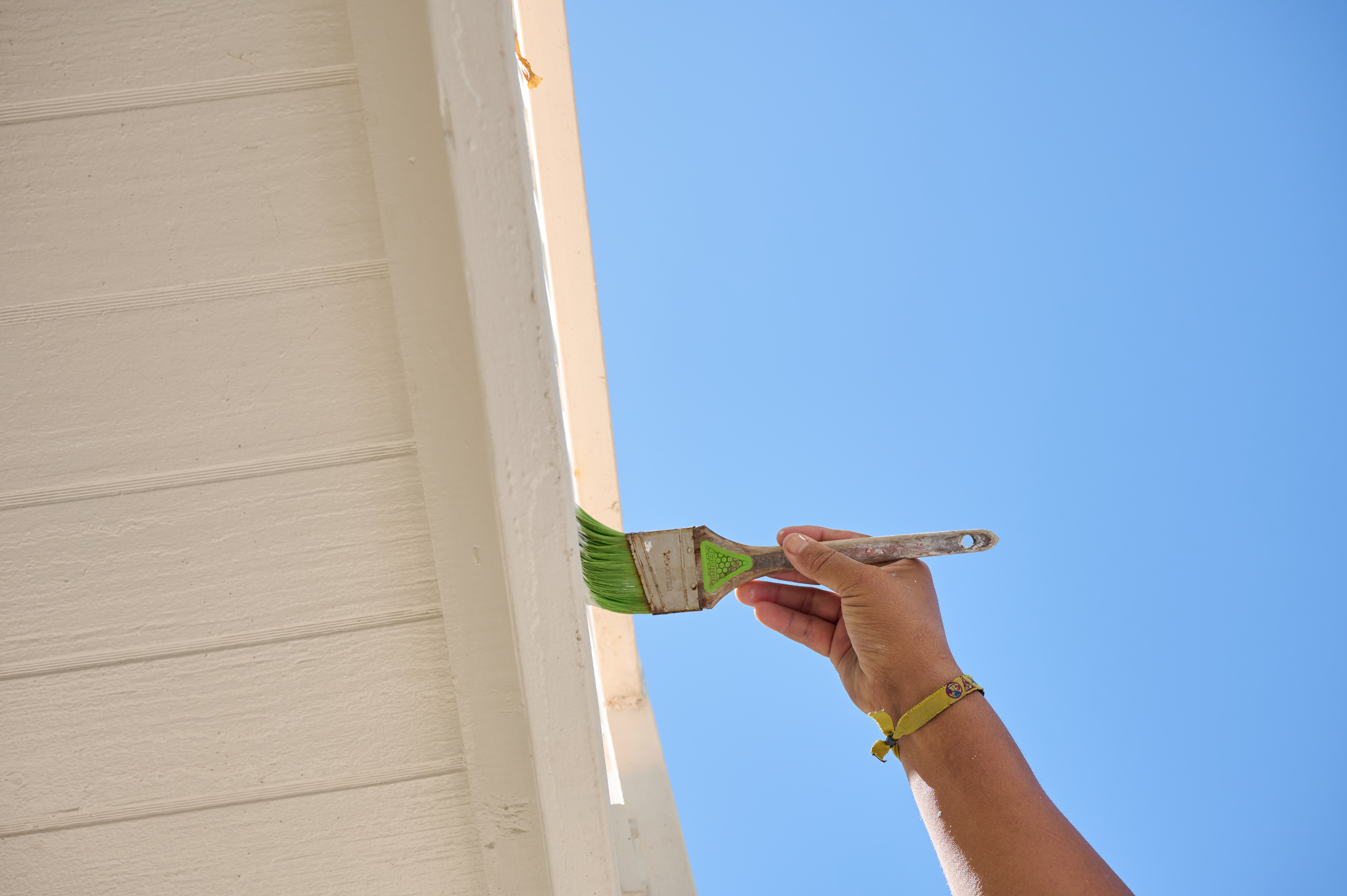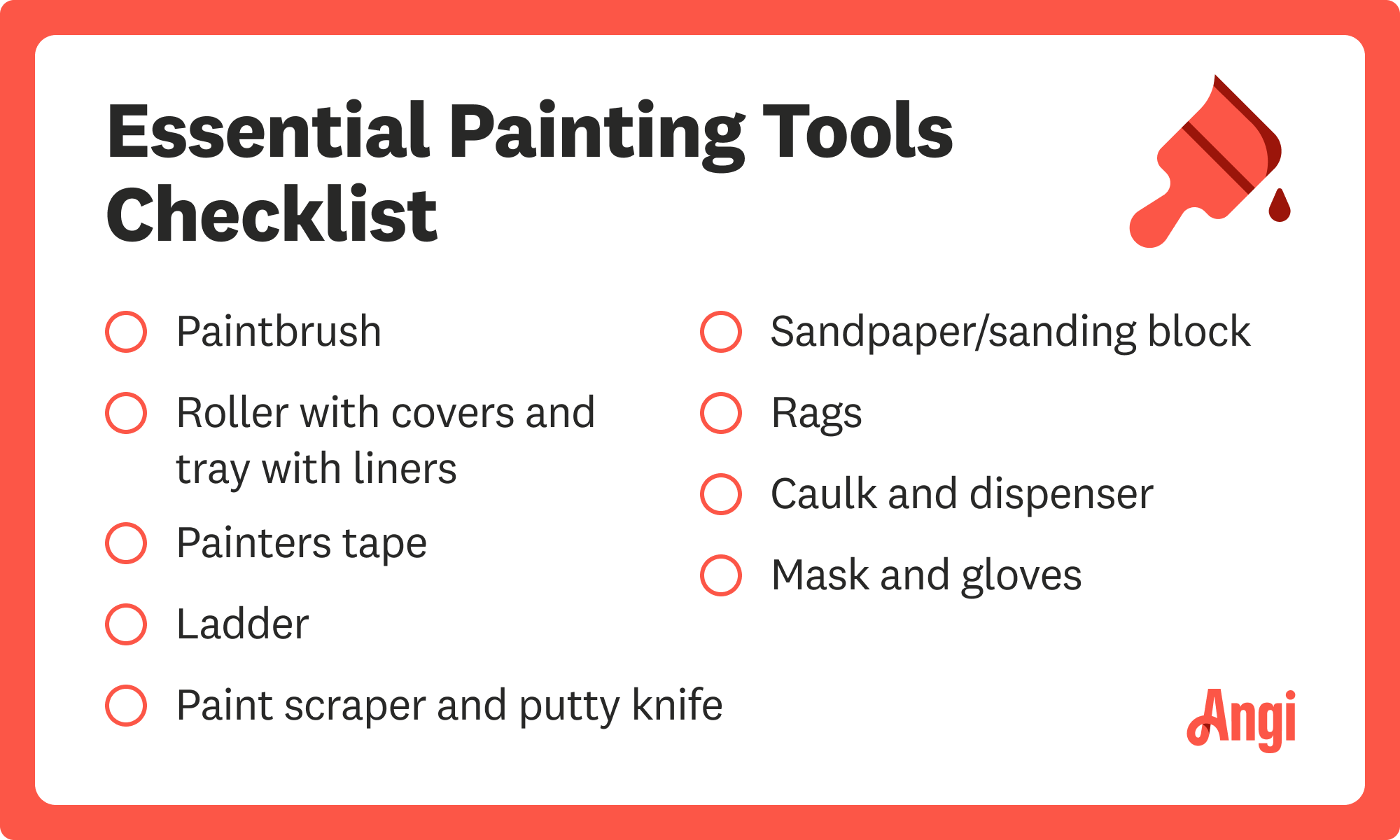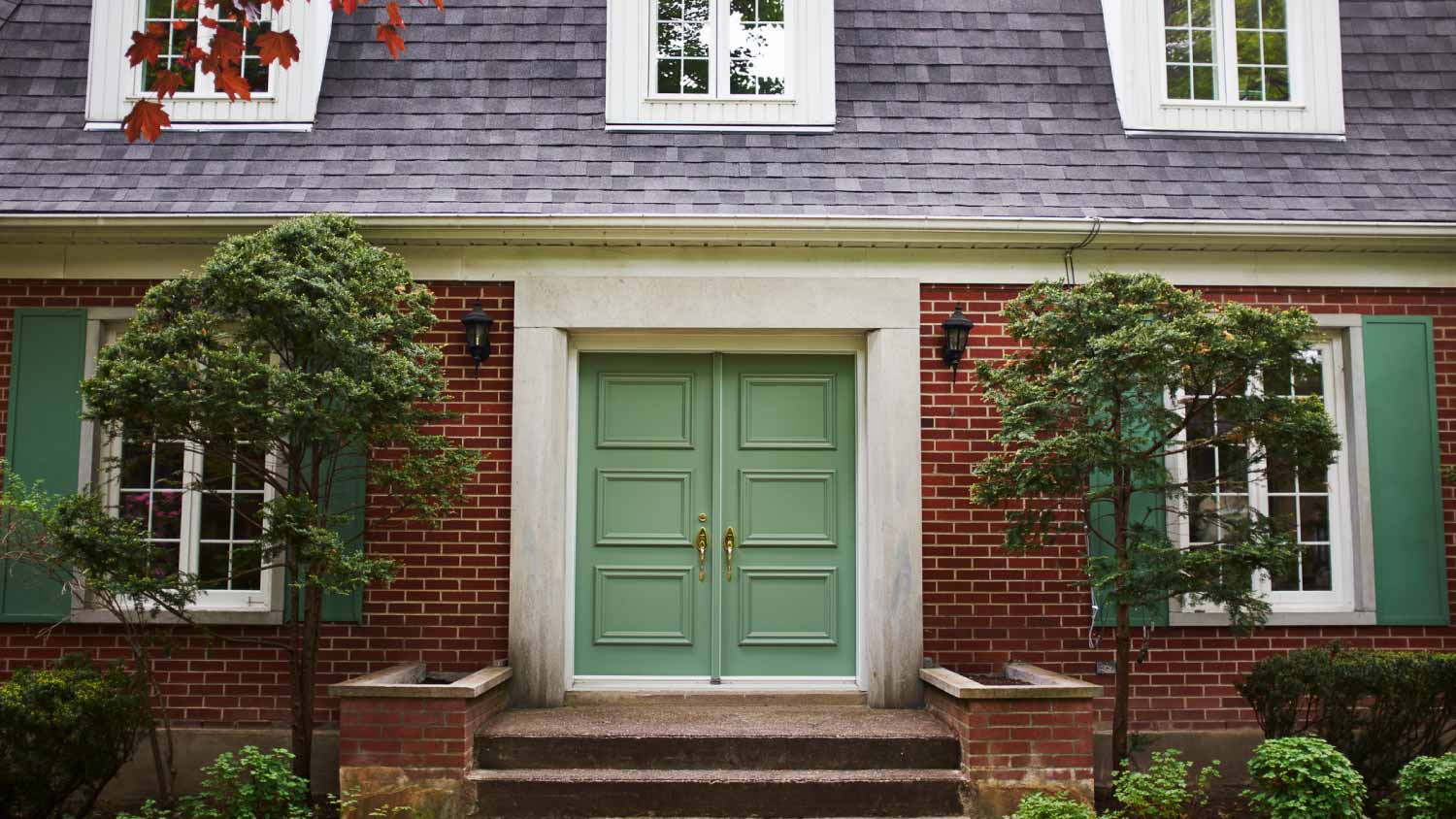
Painting your gutters can give your home the fresh finishing touch it needs to look its best. This guide walks you through the cost to paint gutters.
Exterior painting costs depend on your project and location. Check with a local pro for your specific job.
The average cost to paint a deck ranges between $2 to $5 per square foot.
An average 300 square foot deck would cost $600 to $1,500 to paint.
Latex and acrylic paints—popular for decks—are more affordable than oil-based, ranging between $40 to $90 per gallon.
Deck repairs may be necessary before painting and can add $2,000 or more to the total project cost.
Painting a deck ranges from $2 to $5 per square foot, with overall costs ranging from $200 to $2,880. A standard 300-square-foot deck costs $1,000 on average, while a large, multi-level deck will be at the top of the price range. The actual price of your deck’s makeover depends on its condition, size, style, type of paint, and labor costs.
The cost to paint a deck depends on factors including the condition and size of your deck, the kind of paint you use, and the local cost of labor. To help you brush up on your budget, here’s a more detailed breakdown of what to consider.
The average deck is around 300 square feet, but dimensions vary widely depending on your garden space and layout. Based on the average cost of $2 to $5 per square foot, here’s what you could spend on coating some standard deck sizes.
| Deck Dimensions | Average Cost |
|---|---|
| 10’x10’ (100 square feet) | $200–$500 |
| 12’x12’ (144 square feet) | $288–$720 |
| 12’x16’ (192 square feet) | $384–$960 |
| 12’x20’ (240 square feet) | $480–$1,200 |
| 14’x24’ (336 square feet) | $700–$1,680 |
| 16’x24’ (384 square feet) | $800–$1,920 |
| 24’x24’ (576 square feet) | $1,200–$2,880 |
Painting a floating, detached deck with no adornments costs the least because it doesn’t have any extra surface area beyond the deck itself. You’ll need to budget for extra paint and labor if your design involves additional deck parts, such as deck railings, stairways, or a pergola.
Most decks are wood, but you may have a deck made of less common materials like vinyl or metal. You’ll find that more costly adhesive or rust-proof primers are a must for these types of materials, which will up your budget slightly.
The cost to paint a pool deck is typically higher because the paint required for the job often has additional or stronger anti-slip, chemical resistance, and mold and mildew properties.
The material your deck is made of will slightly impact the painting cost. For instance, wooden decks cost a bit less to paint than concrete decks, which require specialized paints. The deck material also affects how many years you'll get out of a paint job. The paint on a composite deck will last longer than paint on a wooden deck.
The paint you use has a modest impact on your budget, but there isn’t a one-size-fits-all paint type for decks. The paint's sheen, base, and protective qualities all play their part in determining what type works for you.
| Paint Type | Average Cost per Gallon |
|---|---|
| Latex | $40–$90 |
| Acrylic | $40–$60 |
| Oil-based | $40–$150 |
Water-based latex and acrylic paints are more affordable, but they might not last as long as durable—but less environmentally friendly—oil-based paints. Unless you go for a 2-in-1 paint, you’ll also need to budget for a primer.
Budget anywhere from $25 to $100 per hour for a professional deck painter to complete the job. It may take around 10 hours to paint a ready-to-go deck, depending on the size and how many coats it needs. If the pro has to sand down an already painted deck, it could add another five hours or more, and they will clock more time making small finishing repairs.
Without proper prep work, you can end up with a shabby paint finish that won’t last nearly as long. Pros wrap these requirements into their final costs, but how much more they add depends on the deck's condition and whether the application is onto bare wood or material that needs repainting. Some elements to consider include:
Power washing: You don’t want lots of dirt and debris on the surface of your deck before getting down to painting. This is a standard part of any good pros deck painting quote. If you want to power wash the deck and don’t have the gear, renting out for a day costs around $50 to rent out for a day.
Sanding: This is essential to the prep work for staining a deck. Without doing this, the stain won’t absorb as effectively. It isn’t as necessary for painting if you already have a smooth surface. If you feel the finish won’t look as polished without some sanding, then budget an extra $1 to $1.50 per square foot to have a pro lightly sand the deck.
Paint stripping: If you're repainting a deck rather than painting a new one for the first time, you'll probably need to strip the old paint. Add $0.50 to $2 per square foot for this process.
The factors above are all essential cost considerations. But other factors could influence how much you need to budget for your deck painting project.
Typically, pros quote the cost to apply one coat of primer and two coats of paint (or just two coats of more pricey 2-in-1 formulas).
In some cases, the number of paint coats you need could be more or less. If you’re painting over an existing painted deck in good condition, one coat to freshen things up could be enough. You might need an additional coat if the paint formula is thinner, you are applying a light color on top of dark wood, or for very heavily trafficked decks.
One gallon of paint costs between $20 and $70 and covers anywhere from 200 to 400 square feet. For more coats, you’ll have to budget for more paint and extra labor costs, as well as sealant. Most deck painting projects use between one and three cans of paint, depending on deck size.
Maintaining your deck helps preserve your paint job longer, keeping this outdoor entertainment space in tip-top condition. If you do a DIY power wash, don’t blast too hard—you could do more harm than good. An annual professional power wash for your deck will set you back around $300 and can help keep your deck in good condition over the years.
Mending any deck damage straight away prevents a minor issue from becoming major and helps maximize the longevity of your deck. Watch out for wobbly railings, warped or loose deck boards, and signs of pest infestations or rot. The average cost of deck repairs is $2,000, but it’s well spent if you can enjoy the space for many years more.
The area you live in can greatly impact your deck painting costs. Not only do labor costs vary wildly across the country, but so do material costs and availability. If there’s a shortage of deck painting supplies, the existing materials will be more expensive. So, if you don’t want to compromise on the look you’ve been dreaming about, it may be better for your wallet to wait until supplies build up again and the cost returns to normal.
As you can imagine, not every month of the year is an ideal time to paint your deck. Deck painting isn’t feasible in temperatures that are too hot or too cold. Get in touch with a few local contractors and ask them what their peak deck painting months are. Then, see if you can schedule your project for a slower month that’s still suitable for deck painting.
You should also weatherproof your deck to help extend its lifespan. To do this, you can either apply a waterproof sealant to act as a moisture barrier. The cost to seal a deck is $0.75 to $4 per square foot, and you should apply it every few years to protect it from moisture and sun exposure.

While painting a deck can be a DIY project, achieving a smooth, long-lasting finish is harder than it looks. A gallon of paint costs between $20 and $70 and covers approximately 300 square feet. However, the real challenge lies in the preparatory work—stripping old paint, sanding every surface, and pressure-washing thoroughly. These steps are essential for preventing peeling and ensuring the paint actually adheres.
If you don’t already own the right tools, need to protect your deck’s structural integrity, or are short on time, hiring a deck painter is a smart investment. Professional deck painting typically ranges from $600 to $1,500, but it often saves homeowners time, hassle, and the risk of costly mistakes.
A professional deck painter can save you time, stress, and costly mistakes. Here’s why it’s worth hiring one:
Pros know exactly how to prep the surface so the stain or paint actually adheres and lasts.
Pros can spot early signs of rot, moisture issues, or structural damage you might miss and recommend deck repairs.
They have access to commercial-grade tools and products that deliver smoother, longer-lasting results.
A pro understands which paints, stains, and sealants work best for your deck’s material and climate.
Professionals can handle tricky areas, such as railings, stairs, corners, and high spots, with precision.
Professional painters are skilled at working at various heights that could be unsafe for the average homeowner.
DIY-ing your deck painting project can save money if you have a deck that isn't too difficult to access or has signs of damage. Here are the tasks most homeowners can tackle, whether you complete the job start to finish or prep the work for a pro:
Perform basic cleaning, sweeping, and debris removal before painting begins.
Power washing the deck (as long as you use the correct pressure).
Light sanding or spot-sanding to smooth rough patches or remove flaking paint.
Brushing or rolling paint on wide, flat, easy-to-reach deck boards.

While you have a professional painter out to redo your decking, it makes sense to do any other necessary paint jobs simultaneously. That way, your painting contractor will likely offer a multi-project discount, and you’ll save on additional disruption further down the line.
Some other areas you may want to consider adding to your painting plan include fences, doors, and the outside of your home. Here’s how those jobs break down so you can work it into your budget:
Fence painting costs: $750 to $4,250 on average
Exterior door painting costs: $150 to $500 each
Home exterior paint costs: $1,800 to $4,400 on average
Looking to shave a little off your final spend? There are some smart strategies to help you cut costs.
Skip the premium paint: Luxury brands often guarantee a long-lasting, flawless finish, but you can find more affordable brands with quality ingredients. If you’re hiring a painting contractor, they can help you on this front.
Do the prep work yourself: If you're worried about your deck painting skills, you can still save big by tackling some or all of the prep work yourself. Power washing and paint stripping are both manageable tasks for DIYers.
Take your time: If you decide to tackle the prep work, don’t do it half-heartedly. Poor prep will negatively impact the finish, and you’ll only have to pay more to fix or redo it down the road.
Identify the type of paint or stain you prefer, as well as whether you want a solid, semi-transparent, or transparent finish.
Share any structural concerns or existing damage you’ve noticed, like soft spots, loose boards, or moisture issues.
Be prepared to give accurate measurements of the deck, including stairs and railings, to help the pro estimate materials and labor.
Share any accessibility constraints, such as tight yard access, pets, or areas of the property that require extra protection.
Home is the most important place on earth, which is why Angi has helped more than 150 million homeowners transform their houses into homes they adore. To help homeowners with their next project, Angi provides readers with the most accurate cost data and upholds strict editorial standards. We extensively research project costs to develop the pricing data you see, so you can make the best decisions for you and your home. We rely on reputable sources, including the U.S. Bureau of Labor Statistics, academic journals, market studies, and interviews with industry experts—all to ensure our prices reflect real-world projects.
Want to help us improve our cost data? Send us a recent project quote to [email protected]. Quotes and personal information will not be shared publicly.
From average costs to expert advice, get all the answers you need to get your job done.

Painting your gutters can give your home the fresh finishing touch it needs to look its best. This guide walks you through the cost to paint gutters.

Do you want the color of your exterior doors to really pop? Learn about the labor cost to paint the front door, back door, and other entranceways.

The cost to paint aluminum siding depends on several factors, including type of paint and labor cost. What are the pros and cons of DIY or hiring a painter?

Find out which paints are the best for the stucco exterior of your home. Learn what types are best for durability, color selection, and mildew resistance.

Should you use ceramic paint on your home’s exterior? Learn the pros and cons of choosing ceramic coating for your home, including warranty information, UV protection, and the cost compared to traditional house paint like latex.

Knowing how to pick a front door color will help you achieve the style you desire and boost your curb appeal.